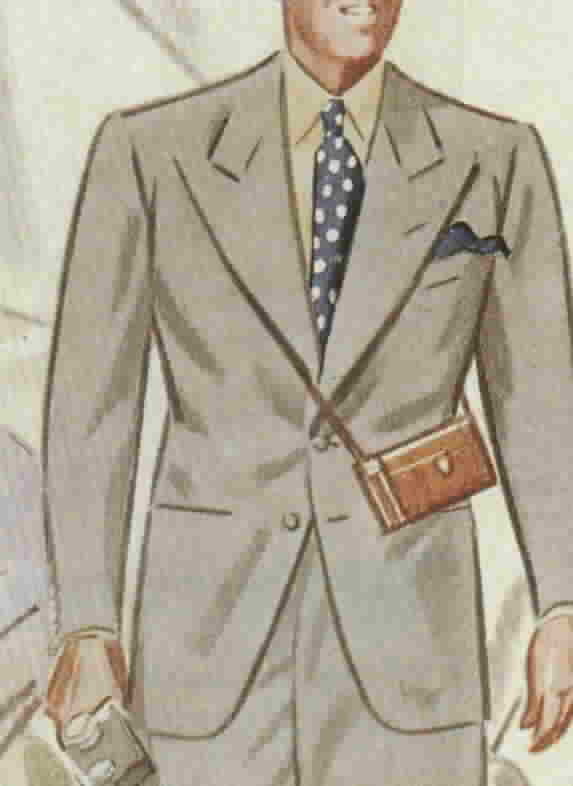
BUSINESS SUIT

As soon as he saw that it was daylight, being by no means
slothful, the knight quitted his downy couch and proceeded to dress himself,
donning his chamois-skin suit and drawing on his traveling boots
to hide the rents in his hose. Over all he threw his scarlet cloak and, placing
on his head a cap of green velvet trimmed in silver, he strapped on his
baldric and his good keen-bladed sword and then picked up a large rosary that he
always carried and with a solemn strut set out for the anteroom where the duke and
duchess, already dressed, appeared to be expecting him.
--Miguel de Cervantes (Don Quixote, 1605:804)
He [Cary Grant] had a wide head so he wore his
shoulders wider to balance it. -- Alan Flusser (Sporkin
2000:137)
Taking off your jacket
creates an atmosphere of trust. --Veronique Vienne
(1997:154)
Usage: Strength cues from the broadside
display are tailored into every Brooks Brothers suit. A coat's
squared shoulders exaggerate the size and "strength" of the upright
torso. Dropped to fingertip level, the jacket's hemline visually
enlarges the upper body to pongid (i.e., gorilla-like) proportions. Flaring
upward and outward, lapels enhance the illusion of primate pectoral
strength. Pads and epaulets cover inadvertent shrugs and slips of the shoulder blades, to mask
feelings of submission or uncertainty, in the boardroom or on the
battlefield.
Business. 1. "The best suit colors [for men]
are navy [see below, U.S. Politics, Symbolism], medium blue, tan,
and all shades of gray. Brown is a color that demands caution. A lot of people
have a negative reaction to it, and it can easily look cheap" (Bixler 1984:112).
2. "A well-cut, well-fitting [women's] suit can be accessorized into an
office look without being frilly, authoritative without being dull" (Bixler
1984:148). 3. "The best basic colors for women are black, brown to camel,
burgundy, blue to navy, beige to taupe, and all shades of gray. The darker the
color, the more authority the suit will impart to the woman wearing it. In some
workplaces, women need all the power support from their clothing that they can
get" (Bixler 1984:157).
Evolution. Through a process of
consumer product selection, business suits today resemble power uniforms. As a
fashion statement, the broadside display may first have appeared in
animal-hide clothing of the Neanderthals, ca. 200,000 years ago. The first solid
evidence for the display, however, appears in the Roman toga. As early
as 200 B.C., men in tunics draped wool or linen toga-cloths over their
left shoulders, to make the upper body look "thicker" and more formidable than
when dressed in a tunic alone (Rowland-Warne 1992).
Literature.
"Beowulf put on his warrior's dress, had no fear for his life. His war-shirt,
hand-fashioned, broad and well-worked, was . . . to cover his body-cave so that
foe's grip might not harm his heart, or grasp of angry enemy his life."
--Beowulf (ca. 1,200 years old)
Natural history. Konrad
Lorenz (1966) hypothesized that fish adopt the bright colorations and markings
of rival fish species, to reduce attack and "escape from interspecific
aggression."
Recent history. From togas to doublets (1300s), to
shortcoats (1600s), court coats (1700s), and sport
coats (1990s), clothing enabled men to seem "bigger" and to present
"larger" versions of themselves in public. Today, the conservative design of the
business suit allows men and women to display a more powerful, influential
silhouette in business and public affairs.
U.S. Politics I. "Dark
blueness is all. The Blue Suit Endureth in Washington, a monument to sobriety
and every politician's right to pursue the electoral majority and look okay on
television [see MEDIA]. This dates, as does everything else in modern
history, it seems, to that great benchmark of American politics: the first
Kennedy-Nixon debate in 1960. Richard Nixon--pale and sweating, his shirt collar
loose on his neck from a recent illness--wore a light gray suit. Light
gray. It made Nixon seem insubstantial and meek. On black and white
television, he and the backdrop were the same color, a combination of wet cement
and cardboard. He became invisible but for a pair of rubbery hands wiping sweat
on his ashen face with a white hankie" (Sherrill 1992:31).
U.S.
Politics II. "John Kennedy's handkerchief stayed in his pocket. He had a
slight tan. His suit was deep and dark and blue" (Sherrill
1992:31).
SEMANTICS: 1. The
contemporary success suit (Molloy 1988) is replete with frozen
gestures (Hall 1959) which suggest muscular strength and bulk. Unlike body
movements that come and go, a suit's "pumped" arms (see ARM-SHOW) and squared shoulders beam continuously from
a wearer's frame. 2. The crisp, tailored look frames a
permanently established "wedge" shape. Lapels lie flat, buttons blend in, and
shoulders are firmly defined within the jacket's stable edges and secure collar.
3. As a protective garment, the suit sacrifices personality for
strength. Instead of loud plaids or bright colors, e.g., darker shades of grey,
green, and navy blue convey a serious, formal look. (Because the latter
hue contains black but is not forbiddingly dark itself, navy remains the
preferable power color of the corporate world.)
Symbolism. Dark blue seems "heavier" and more "serious" than lighter colors, e.g., pinks and yellows, which feel both physically and emotionally "lighter" than navy. Blue itself creates a calm, pleasant, transcendent mood, and symbolizes dignity and truth (Richmond et al. 1991). Adding black's symbolic power to blue makes navy the ideal choice for business. Black alone is too "intense," dark brown too "sad," and light grey too "insubstantial" for influence peddling in Nonverbal World.
See also MEN'S SHOES, NECKWEAR, SHOULDERS, WOMEN'S
SHOES.
YouTube Video: Perfectly Suited--the Delta Blues Boys in a Pluperfect Performance of "Dry Bones"
Copyright
1998 - 2016 (David B.
Givens/Center for Nonverbal Studies)
Detail of
illustration of vintage suit (and camera carrying case; copyright Esquire
Magazine)